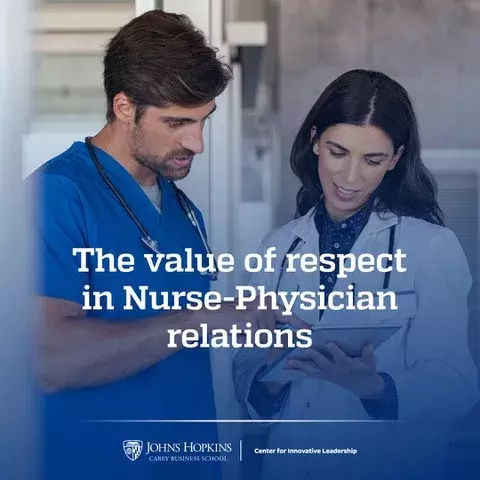Ineffective collaboration between physicians and nurses in acute healthcare settings is known to lead to substandard patient outcomes. A new review highlights the role of respect in promoting better interprofessional relationships, offering insights to help leaders encourage and maintain respectful attitudes and behavior.

The Value of Respect in Nurse-Physician Relations
Summary
Team effectiveness is greatly affected by the quality of interpersonal relationships —with poor collaboration leading to poor performance. Nowhere is this of greater concern than in healthcare environments, where patient safety is at stake. A review of previous research reveals the extent to which subpar nurse-physician collaboration can be due to a lack of respect. This review differentiates between respect for task-relevant capabilities and that for human rights, synthesizing evidence about how both emerge, how they relate, and how to avoid rewarding one while hoping for the other. The review is of special value to leaders aiming to foster effective nurse-physician collaboration and better patient outcomes and has wider implications for any interprofessional collaboration.
The uneven power dynamics at play in healthcare settings have long been acknowledged as a source of discord, potentially detrimental to staff wellbeing and performance, and ultimately to patient safety. Patient care, particularly in acute care settings, involves frequent collaboration between nurses and physicians, sharing and integrating knowledge, managing disagreements, and coordinating action to deliver the best course of treatment. A deep-rooted power dynamic favoring physicians above nurses—a hierarchy that can sometimes be a useful coordinating mechanism—can also undermine collaboration when lower-status individuals hold important information and perform essential tasks, yet are ignored. Fortunately, cultivating respect between professions might clear the way for more productive collaboration.
With this in mind, Anna Mayo and Derrick Bransby, affiliates of the Center for Innovative Leadership at Johns Hopkins Carey Business School, reviewed research about respect between nurses and physicians in acute care settings, and synthesized the evidence to offer new insights that all collaborative leaders should be aware of.
Why does respect matter?
The research reviewed suggests that respectful nurse-physician interactions are associated with better collaboration, communication, and conflict resolution. Respect can also generate positive outcomes for both parties, such as less stress and greater job satisfaction. For example, an intervention creating an explicit role for nurses during bedside rounds increased nurses’ reports of feeling valued, while also increasing patient satisfaction and shortening the length of stay. Cultivating respect between health care professionals thus has potential to improve performance and even enhance patient outcomes.
What is respect?
Although respect was generally characterized as a judgment of one’s own and others’ value and worth, few studies defined it outright, and there was ample variance in how it was conceptualized. For example, many papers depicted respect in terms of behaviors, while fewer did so in terms of attitudes (i.e., what we think). Likewise, studies were split about who was being respected (i.e., the target of respect). Some examined respect granted to individuals while others investigated that accorded to groups (e.g., nurses). Variance in this dimension reflects a challenge with practical relevance. In acute care, where dynamic staffing arrangements are on the rise, it is easy to confuse respect for individuals and groups, such as in situations where nurses and physicians share a patient having rarely, if ever, worked together before, lacking familiarity or direct knowledge of the other’s skills, work ethic, or integrity. In this case, cultivating respect for nurses in general (a group), for example, could be just as or more important than respect for individuals in generating fruitful collaborations.
While there was also variety about what was being respected (i.e., the object of respect) a vast majority of the work reviewed focused on respect for others’ task-relevant capabilities (i.e., expertise, knowledge, skills) in contrast to human rights (i.e., the inherent worth of humans). When differentiated along this dimension, the work reviewed offered new insights into the mechanisms, outcomes, and origins of respect, suggesting how it might be encouraged, developed, and maintained over time.
Professional and humanistic respect
Accordingly, Mayo, Bransby, and colleagues proposed that respect for task-relevant capabilities, which they labeled “professional respect,” is earned and implies that someone is worth listening to. It is a means of differentiation, of finding who has relevant expertise for a task in a particular moment. Respect for human rights, or “humanistic respect,“ is a belief in the general value of others as humans; it is expected and acts as an equalizing force, implying that everyone should be treated equitably with civility. In the work reviewed, humanistic respect emerged as likely useful for preventing conflict, but in interprofessional work conflict is often inherent. To this end, professional respect emerged as consistently related to better collaboration, the management of conflict, and patient and provider outcomes. Despite this distinction, in practice, many organizations emphasize humanistic respect or conflate the two, helping us understand why professional respect and the associated better collaborations may remain elusive in organizations.
Origins of respect
Viewed through this lens, the work reviewed implied that humanistic respect emerged from group norms that recognized the inherent worth of every individual, whereas professional respect emerged from three sources: professional status, an individual’s specific and relevant knowledge and competence, and the expectations of a person’s capabilities based on their group membership. In dynamic acute care environments, where familiarity is limited, leaders might engage in tactics that improve the understanding of one’s own and others’ roles (e.g., the role of a nurse) to increase the likelihood of professions signal competence (and not status). Practically, the literature provides evidence that interventions designed to expose employees to professions other than their own (e.g., immersive rotations and job shadowing) foster role understanding, generating professional respect. Profession-based respect rooted in an awareness of others’ competencies should aid in appropriately differentiating between individuals so that one can uncover and weigh others’ input dynamically and in an effective manner. Critically, professional status hierarchies may be zero-sum, but professional respect anchored in understanding one’s role in a task need not be, thus minimizing the risk of status conflict.
What to Read Next

research
How Female CHROs Break the Glass Ceiling of the C-suiteConclusion
Healthcare delivery demands collaboration. Yet, it remains a pervasive challenge. Fortunately, cultivating respect might be a means for improvement. However, while respect for other’s as human beings (i.e., humanistic respect) is required to facilitate civil interactions between nurses and physicians, it is not, alone, sufficient for enhancing collaboration. Instead, the evidence suggests that health care organizations would be wise to nurture professional respect by engaging in tactics that improve the understanding of one’s own and others’ role-based capabilities. With a better understanding of the types of respect and how they interrelate, savvy leaders will avoid rewarding one, while merely hoping for the other.
Access the full review here:
A systematic review of respect between acute care nurses and physicians, Health Care Manage Review, 2023.
Derrick P Bransby, Anna T Mayo, Matthew A Cronin, Katie Park, Christina T Yuan
DOI: 10.1097/HMR.000000000000037
The Center for Innovative Leadership (CIL) at the Carey Business School aims to advance knowledge and build capacity for innovative leadership in modern organizations. CIL is a hub for new ideas and insights on leadership, combining faculty-led research, student-facing programming, and community-focused impact.


